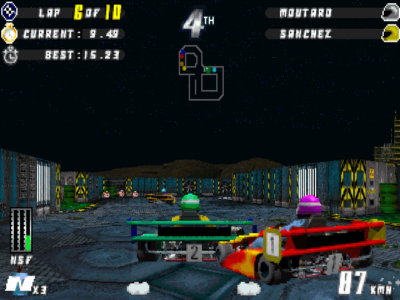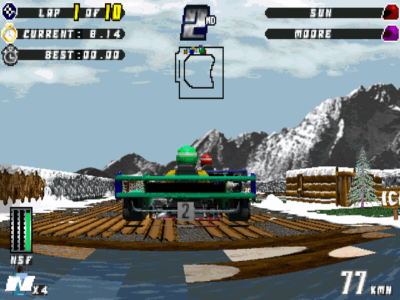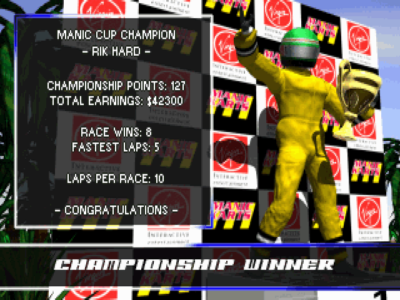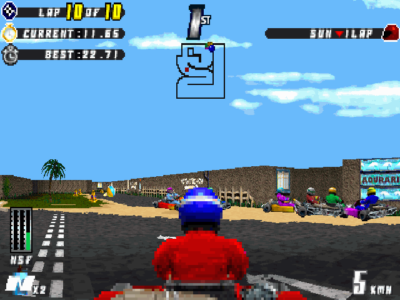
Manic Karts
Written by: Rik
Date posted: September 1, 2022
- Genre: Racing
- Developed by: Manic Media Productions
- Published by: Virgin Interactive Entertainment
- Year released: 1995
- Our score: 6
I was going to start this review by claiming that there were loads of karting games on the PC in the mid-90s. But, as is so often the case, even the briefest moment’s research proves that Rik from the famous gaming site A Force for Good does not know what he is talking about. Instead, ‘a few, including some with rather similar sounding names’ would be a more accurate way to sum things up, and as it turns out three of the titles that most readily spring to mind were all developed by the same studio, Manic Media Productions.
Manic Karts is a follow-up to SuperKarts, which we’ve already covered, although according to the information available, both games were released in the same year, which to me seems like a decision based on a significant over-estimate of the likely demand among the DOS gaming public for knockabout karting-based arcade racing. SuperKarts was quite good, as I remember, although I don’t recall having an urgent desire to play a largely similar game a few months later. (Oh, and Formula Karts was the third Manic Media game, released in 1997, in case you were wondering).

Getting rear-ended by Sanchez. Oh, Sanchez, you old devil – can’t you see I’m hot on the heels of Moutard in third place?
Although absent of any oversized cartoon characters in tiny karts, SuperKarts was still fairly light-hearted in tone, with a sherbet colour palette and an array of Street Fighter II style portraits representing opponents from around the world. Manic Karts seems to have dialled that back in both regards, with a more muted and perhaps (by the standard of the day) realistic graphical style.
At the risk of reading far too much into things, 1995 was also the year in which the PlayStation came out, bringing with it, according to popular folklore, a sense of ‘edge’ and ‘cool’ that the hitherto dorky pastime of gaming was lacking. Nowhere was this new attitude more prevalent than in magazine advertising campaigns, which chose to promote even the most neutral and uncontroversial titles with desperate and often obnoxious attempts to grab the reader’s attention, although there was also a definite shift in approach within the games themselves.
In some ways, the superficial differences between SuperKarts and Manic Karts summarise that shift: the bright colours and breezy naivety of the earlier game replaced by something greyer and grimier, and now accompanied by a thudding techno soundtrack, as if every arcade racer suddenly needed to somehow resemble Wipeout. (I did resist turning it off, judging that it just about fell short of migraine-inducing noise, and with the realisation that complaining about loud in-game music in the manner of an extremely old man seems to be becoming a recurring theme in these write-ups).
In most respects, though, they’re largely similar games. The arcade mode is no more, while the championship is – as before – playable in one of two halves (the easy tracks or hard tracks) or in its entirety, encompassing all 16 circuits, and now known as the Manic Cup. Difficulty is expressed in terms of engine size, with four levels available from 50-250cc, and the top two distinguished from the bottom two by beefier-looking in-game karts.
There are no longer any on-track pickups, with prize money awarded based on your finishing position alone, while the largely useless oil slick has been dropped altogether (although the equally useless super-tyres remain). Hitting the turbo no longer triggers an aesthetically pleasing (and practically useful) flame effect, although a gauge on the HUD does show you how much of each individual boost is remaining once engaged, along with the overall number of each that you have left. Between races, you can spend prize money on engine and tyre upgrades, as well as on topping up your power-ups, as before.
Last time, I brazenly ignored pit stops on the basis that the default four lap races did not require them and I saw no reason to artificially extend their length. After breezing through a couple of championships on the easiest difficulty in Manic Karts, however, the individual races seemed to be over in a matter of seconds, and so I resolved to whack it up to 10 laps for the rest of the game and see what difference it made.
Perhaps unsurprisingly, it’s not exactly complex stuff. As far as I could tell, at least one pit stop is required in each race regardless of how much money had been spent on a fuel tank, and on some of the longer courses at least two are needed. I had assumed that the money spent on tank upgrades would eventually eradicate the need for any stops, but it seems to be expected that you prioritise spending money on the fuel tank as much as on the engine and tyres in order to be on a par with the rest of the field. Pit stops do also provide a refreshment of your supply of turbo and super-tyres, too, though, so I guess there is some strategy to it.
Otherwise, Manic Karts has most of the same strengths and weaknesses as SuperKarts. The racing itself holds up pretty well, with most tracks easily committed to memory within a few laps, while opponents are generally tenacious but not unfairly so (at least not until you try the 250cc difficulty, which was a step too far for me), and in general all of the various knobs and dials that make for a decent lightweight racing experience have been turned in the right general direction here. I have a weakness for any ageing racer that allows you to quickly get into a rhythm and is largely playable with the four arrow keys, and this certainly ticks those boxes.
Other additions not mentioned so far include an SVGA mode, which sharpens the visuals without highlighting anything that a blockier lower resolution might have hidden, and the fact that some tracks have on-track obstacles like cones that can be bashed away for a low-key thrill [you really need to get out more – Ed].
On the minus side, some of the circuit layouts remain a little bit confusing, particularly when trying to factor in the location of the pits (there is a map but looking at it for too long does place your on-track performance in jeopardy). Indeed, some are too confusing for your AI opponents, who on one or two of the harder circuits can be found clumped together circling a particularly tricky bend and repeatedly getting stuck on the scenery. Oh, and there’s no local multiplayer either, which came as a disappointment to all the friends that I regularly invite round to play old DOS games with me at weekends. (Sorry again, guys!)
I had a reasonably good time with Manic Karts although, as previously noted, I’m not sure I’d have been quite so eager to dive in again had I just finished with SuperKarts (and I definitely wouldn’t have been urgently running down to the shops with cash in hand at the time). I actually did own this game in the 1990s, although I have absolutely no memory of ever playing it, and it has to be said that the desire to get to the bottom of that personal mystery was part of the motivation for checking it out. For everyone else, it’s arguably a slight upgrade on SuperKarts, although for my money some of its predecessor’s cheer and charm has been sanded off along the way.





 Posts
Posts
Was this all Mario Kart’s fault, or was kart racing (presumably the real kind) a big deal in the U.K. prior? It sure wasn’t in the States.
MobyGames suggests a few kart racers on the Spectrum before Mario, but that’s about it.
September 2, 2022 @ 5:43 am
I’d guess Mario Kart was to blame for all these karting games. That was the line I was going to take before I realised ‘all these karting games’ didn’t amount to that many really. Wacky Wheels, Skunny Karts, three from Manic Media… and Virtual Karts, from Microprose, was the other mid-90s one, although that took a more serious approach.
I have a vague memory that show-off kids might have had birthday parties at go-kart tracks in the 90s, as an upgrade from 10-pin bowling or laser quest. (Maybe?) But don’t remember it being a big deal.
September 2, 2022 @ 3:46 pm
It’s missing the split screen two-player mode, isn’t it?
September 13, 2022 @ 5:41 pm
It is indeed. (That’s what I meant by ‘no local multiplayer’ 🙂 )
A curious omission, no doubt, and potentially troublesome for the 90s gamer with friends, if not for the 40-something battling through it alone years later.
September 13, 2022 @ 8:42 pm